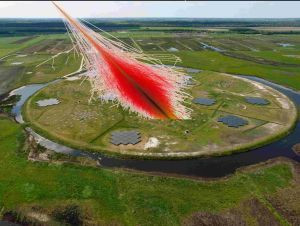Astrophysicists use KIT simulation to analyse cosmic rays

Speculations that there were cosmic rays hitting Earth in early 2016 turns out to be true. However, the rays does not come from Mars but from the super-massive black hole at the centre of the galaxy.
It is the most plausible source of the cosmic ray acceleration, says Gavin Rowell, from the University of Adelaide, according to the study published on Thursday in Nature, reports Cosmosmagazine. Astrophysicists have actually been studying for generations the source of the cosmic rays for generations.
Using the Low Frequency Array (LOFAR) Telescope provides not just the potential sources of the rays but its mass via simulation developed by the Karlsruhe Institute of Technology (KIT). Tim Huege, from the Institute of Nuclear Physics of KIT, says they found there were a “high number of light particles, protons and helium nuclei, at energies of 10 to the power of 17 to 10 to the power of 17,5 electron volts.”
Had they found heavy particles, it would have been remnants of supernova. But the discovery of more light particles point to a source of extragalactic origin. Huege points out that experts already know cosmic rays of highest energies are produced in the most energetic extragalactic sources only.
What remains unknown is the energy range the transition takes place. Using the simulation code CoREAS, or CORSIKA-based Radio Emission from Air Showers, developed at KIT, provided information of the energy range of the transition. The code evaluates the measurement of the radio antennaes and interpret the signals precisely, he explains.
Astroparticle physicists perform up to 100 simulations to exactly classify a signal using CoREAS. They used hundreds of LOFAR antennaes in Exloo, The Netherlands, to measure the arrival direction, energy and mass of the light particles, says Huege. Only simulations could determine reliably and continuously the Xmax, the depth of the penetration of air showers into the Earth’s atmosphere.
KIT developed CoREAS over a decade. It is within the framework of the Pierre Auger Observatory in Argentina, a global astrophysical large-scale experiment with major contributions by KIT and other German universities. Launched in 1989 and cited by almost 700 scientific publications, reviewed by peers, of air shower experiments worldwide, CORSIKA is undergoing further development and is continuously complemented with new interaction models.





















